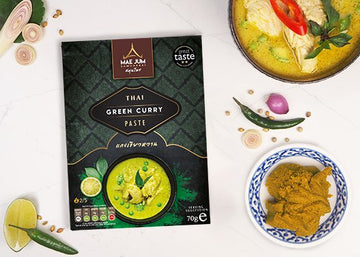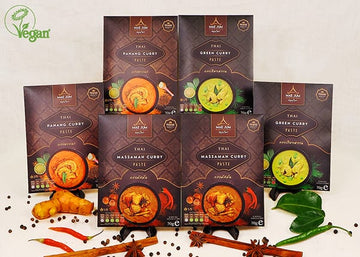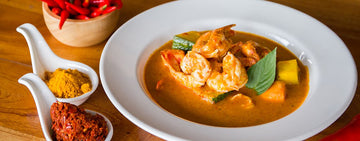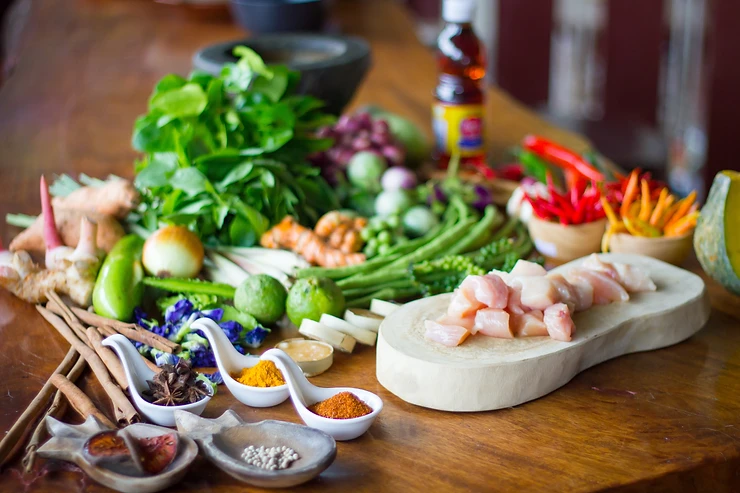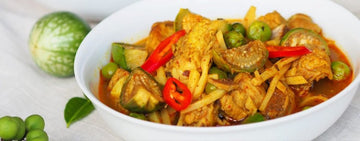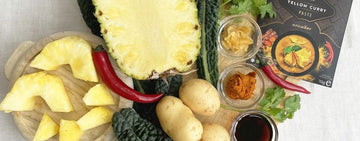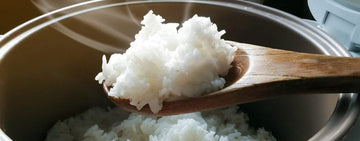The Secret to a Perfect Thai Curry: Fresh Ingredients, Balanced Flavours, and Authentic Techniques
When it comes to Thai cuisine, freshness is paramount, and this is especially true when making a Thai curry. Fresh herbs, vegetables, and spices bring the vibrant, rich, and complex flavours that are essential to authentic Thai dishes. Whether you’re preparing a fiery green curry or a mild Massaman curry, using fresh, high-quality ingredients is the key to achieving that perfect blend of sour, sweet, salty, and spicy that Thai food is renowned for.
While the UK has seen an explosion of Thai ingredients on supermarket shelves over the past few decades, not all products are created equal. If you want to experience the full depth of flavour in your Thai cooking, it’s important to source the best ingredients you can find. Organic or farm-grown produce is ideal, as it brings out the natural goodness in your curry, enhancing both flavour and texture.
The Importance of Fresh Ingredients in Thai Curries
The heart of a Thai curry lies in the balance of flavours. Achieving the perfect harmony between sourness, sweetness, saltiness, and spiciness is essential for crafting an authentic dish. In order to do this, it’s not just about following a recipe—it’s about using fresh, well-balanced ingredients in the right proportions.
For many home cooks, making a Thai curry begins with a concentrated paste made from a variety of fresh herbs, spices, and aromatics. This paste acts as the foundation for many Thai dishes, providing the rich, aromatic base from which the curry sauce is built. There are countless recipes for homemade Thai curry pastes available online, and the ingredients used in each paste vary depending on the type of curry you’re making—whether it’s a green curry, red curry, or yellow curry.
Making Your Own Curry Paste
Creating your own curry paste from scratch is a rewarding process that allows you to fully control the flavours and freshness of your dish. While it does take a bit of time and effort, the result is well worth it. The key to a perfect Thai curry is in the preparation, and this starts with making a paste that bursts with flavour.
To make your own Thai curry paste, you’ll need a mortar and pestle and a selection of fresh and dried ingredients. Dry ingredients like cumin seeds, coriander seeds, and dried chillies should be dry-roasted in a pan to bring out their full flavour.
When blending the ingredients into a paste, it’s important to take your time and make sure everything is thoroughly combined. Break down the fibrous ingredients as much as possible to create a smooth paste. If the paste is too coarse, it may result in a curry that tastes grainy or bitter, so it’s worth putting in the extra effort to ensure a well-blended paste. Also, make sure you fully grind your dry ingredients into a powder first before adding in your wet ingredients, it is much easier to do it this way rather than wet ingredients then dry ingredients.
However, if you’re short on time or prefer a more convenient option, you can use a ready-made curry paste like those from Mae Jum, which are made using high-quality fresh ingredients. Mae Jum’s pastes are designed to deliver the same authentic flavour as homemade pastes, making them a great option for busy cooks who still want to enjoy delicious Thai curries at home.
Preparing Your Ingredients
Once you’ve made or chosen your curry paste, the next step in making the perfect Thai curry is preparing your ingredients. Thai cuisine is as much about preparation as it is about cooking, and getting your ingredients ready before you start cooking is essential to ensure a smooth cooking process.
Vegetables should be cut into bite-sized pieces and added to the curry according to their cooking times. Root vegetables like carrots and potatoes take longer to cook, so they should be added early on. Softer vegetables, such as peppers or courgettes, should be added later to retain their texture. Fresh herbs like coriander, Thai basil, and lime leaves should be added at the end to maintain their freshness and fragrance.
Meats, particularly chicken or beef, should be sliced thinly so that they cook quickly and evenly. Prawns should be peeled down to the tail and butterflied to allow them to cook through while retaining their tenderness. Keeping these elements in mind will help ensure your curry is cooked to perfection.

Making the Curry Sauce
Most Thai curries use coconut milk to create the rich, creamy sauce that binds all the flavours together. Coconut milk adds both sweetness and texture to the dish, and for an authentic Thai curry, it’s important to use full-fat coconut milk. Low-fat or “lite” varieties simply don’t offer the same creaminess and can result in a curry that’s watery and lacks depth of flavour.
There’s no need to add oil when making a Thai curry if you’re using a fresh homemade paste or a high-quality pre-made paste like Mae Jum’s. In traditional Thai cooking, the oil comes naturally from the coconut milk itself. When making the curry sauce, start by adding a few tablespoons of unshaken coconut milk to a pan and bring it to a boil. As the milk heats, the coconut oil will begin to separate from the liquid. This is a good thing! The natural oil from the coconut milk adds richness to the sauce and helps to bring out the full flavour of the curry paste.
Once the oil has separated, add your curry paste and fry it in the coconut oil for a few minutes. This step is crucial as it allows the paste to release its full flavour. Be careful not to overcook the paste, as this can cause it to become bitter. After the paste has been fried, you can gradually add the remaining coconut milk to create a smooth, creamy sauce. Avoid boiling the coconut milk too vigorously, as this can cause it to split.
Adding the Meat, Vegetables, and Seasoning
Once your sauce is ready, it’s time to add the other ingredients. If you’re using meat or seafood, add it to the sauce and allow it to cook through. For meats like chicken or beef, this should only take a few minutes if the meat is sliced thinly. Prawns will cook even faster and should only be added at the very end to prevent them from becoming rubbery.
Vegetables should be added according to their cooking times. Root vegetables should be added first, as they take the longest to cook, while softer vegetables should be added later to maintain their texture. It’s important not to overcook the vegetables, as they should still have a slight bite when the curry is served.
Once all the ingredients are in the pan, it’s time to season the curry. Fish sauce and palm sugar are the traditional seasonings used in Thai curries. Fish sauce adds saltiness and umami, while palm sugar adds sweetness to balance the spice. Adjust the seasoning to taste, but be mindful of keeping the balance of flavours in check.
If you’re preparing the curry ahead of time for a dinner party, you can turn off the heat after seasoning and leave the curry to sit until you’re ready to serve. Thai curries, especially those with meat and root vegetables, can benefit from sitting for a while as the flavours continue to meld together. However, you should avoid reheating the curry for too long, as this can cause the coconut milk to split.
The Final Touches
Once your curry is fully cooked, it’s time to add the finishing touches. Fresh herbs like Thai basil, coriander, or kaffir lime leaves can be added at the very end to give the dish a burst of freshness and fragrance. A squeeze of fresh lime juice adds a final touch of sourness, balancing the richness of the coconut milk and the spice of the curry paste.
For extra texture, you can also add roasted peanuts or dried chillies. These ingredients not only enhance the flavour but also add visual appeal to the dish. Thai food is as much about presentation as it is about taste, so don’t be afraid to garnish your curry with fresh herbs and vibrant red chillies for a dish that looks as beautiful as it tastes.

Conclusion: The Perfect Thai Curry at Home
Making the perfect Thai curry at home may seem daunting at first, but by following a few simple principles, you can achieve an authentic and delicious result every time. Freshness is key—whether you’re making your own curry paste or using a high-quality pre-made paste, the ingredients you use will make all the difference.
Remember to use full-fat coconut milk for a rich, creamy sauce, and season your curry carefully to achieve the perfect balance of sour, sweet, salty, and spicy. With a little practice, you’ll soon be making Thai curries that rival your favourite restaurant dishes, and you’ll have the added satisfaction of knowing you made them from scratch.
Above all, enjoy the process. Thai cooking is about experimenting with flavours, textures, and ingredients, and it’s a wonderful way to share a delicious meal with family and friends. Whether you’re making a simple weeknight curry or preparing a show-stopping dish for a dinner party, a homemade Thai curry is sure to impress and satisfy.
If you enjoyed reading how to make the perfect Thai curry, please give this post a rating and subscribe for new blog updates and recipes. Follow and tag us @maejumsamunprai on social media for great foodie content and giveaway competitions! Read more on our blogs today!
